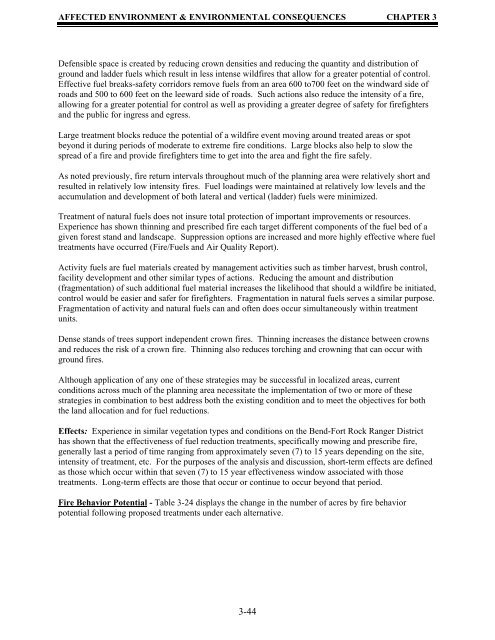Environmental Assessment
Environmental Assessment
Environmental Assessment
You also want an ePaper? Increase the reach of your titles
YUMPU automatically turns print PDFs into web optimized ePapers that Google loves.
AFFECTED ENVIRONMENT & ENVIRONMENTAL CONSEQUENCES CHAPTER 3<br />
Defensible space is created by reducing crown densities and reducing the quantity and distribution of<br />
ground and ladder fuels which result in less intense wildfires that allow for a greater potential of control.<br />
Effective fuel breaks-safety corridors remove fuels from an area 600 to700 feet on the windward side of<br />
roads and 500 to 600 feet on the leeward side of roads. Such actions also reduce the intensity of a fire,<br />
allowing for a greater potential for control as well as providing a greater degree of safety for firefighters<br />
and the public for ingress and egress.<br />
Large treatment blocks reduce the potential of a wildfire event moving around treated areas or spot<br />
beyond it during periods of moderate to extreme fire conditions. Large blocks also help to slow the<br />
spread of a fire and provide firefighters time to get into the area and fight the fire safely.<br />
As noted previously, fire return intervals throughout much of the planning area were relatively short and<br />
resulted in relatively low intensity fires. Fuel loadings were maintained at relatively low levels and the<br />
accumulation and development of both lateral and vertical (ladder) fuels were minimized.<br />
Treatment of natural fuels does not insure total protection of important improvements or resources.<br />
Experience has shown thinning and prescribed fire each target different components of the fuel bed of a<br />
given forest stand and landscape. Suppression options are increased and more highly effective where fuel<br />
treatments have occurred (Fire/Fuels and Air Quality Report).<br />
Activity fuels are fuel materials created by management activities such as timber harvest, brush control,<br />
facility development and other similar types of actions. Reducing the amount and distribution<br />
(fragmentation) of such additional fuel material increases the likelihood that should a wildfire be initiated,<br />
control would be easier and safer for firefighters. Fragmentation in natural fuels serves a similar purpose.<br />
Fragmentation of activity and natural fuels can and often does occur simultaneously within treatment<br />
units.<br />
Dense stands of trees support independent crown fires. Thinning increases the distance between crowns<br />
and reduces the risk of a crown fire. Thinning also reduces torching and crowning that can occur with<br />
ground fires.<br />
Although application of any one of these strategies may be successful in localized areas, current<br />
conditions across much of the planning area necessitate the implementation of two or more of these<br />
strategies in combination to best address both the existing condition and to meet the objectives for both<br />
the land allocation and for fuel reductions.<br />
Effects: Experience in similar vegetation types and conditions on the Bend-Fort Rock Ranger District<br />
has shown that the effectiveness of fuel reduction treatments, specifically mowing and prescribe fire,<br />
generally last a period of time ranging from approximately seven (7) to 15 years depending on the site,<br />
intensity of treatment, etc. For the purposes of the analysis and discussion, short-term effects are defined<br />
as those which occur within that seven (7) to 15 year effectiveness window associated with those<br />
treatments. Long-term effects are those that occur or continue to occur beyond that period.<br />
Fire Behavior Potential - Table 3-24 displays the change in the number of acres by fire behavior<br />
potential following proposed treatments under each alternative.<br />
3-44
















